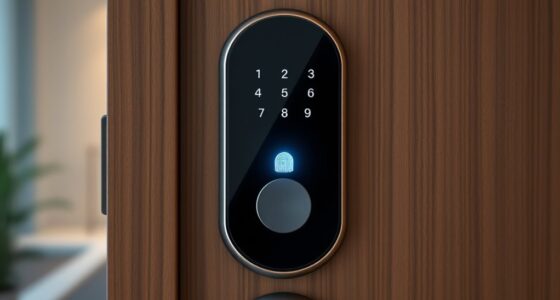If you’re looking for air-gapped mini desktops that are both secure and compact, I recommend the GEEKOM Air12 Lite with its 12th Gen Intel N150 processor, 8GB RAM, and 256GB SSD, perfect for demanding secure environments. The GEEKOM Mini PC Air12 with Intel N100, 16GB DDR5 RAM, and 512GB SSD offers excellent performance and expandability. Both prioritize durability, heat management, and offline security. If these options sound intriguing, there’s more to explore that can help you choose the best fit.
Key Takeaways
- Look for mini desktops with robust, durable chassis materials and secure internal mounting for long-term reliability.
- Prioritize models with strict offline policies supported by physical media update options and minimal wireless interfaces.
- Choose devices with multi-core processors and expandable storage to handle demanding security applications efficiently.
- Select units with advanced cooling and noise reduction features for stable, quiet operation in secure environments.
- Ensure compatibility with legacy or specialized software, emphasizing firmware stability and offline update capabilities.
GEEKOM Air12 Lite Mini PC with 12th Gen Intel N150, 8GB RAM, 256GB SSD

If you’re looking for a compact, reliable mini PC that combines strong performance with versatile connectivity, the GEEKOM Air12 Lite is an excellent choice. Powered by the 12th Gen Intel Alder Lake-N150 processor, it offers over 25% higher performance than previous models and better efficiency. With 8GB of DDR4 RAM and a speedy 256GB PCIe NVMe SSD, multitasking and fast load times are guaranteed. Its extensive ports, including six USB connections and a serial port, support a wide range of peripherals and industrial applications. The Iceblast cooling system keeps temperatures in check, ensuring quiet, reliable operation even during intensive tasks.
Best For: individuals or small businesses seeking a compact, high-performance mini PC with versatile connectivity and reliable cooling for home, office, or industrial applications.
Pros:
- Powered by the latest 12th Gen Intel Alder Lake-N150 processor for superior performance and efficiency
- Extensive port selection including six USB connections and an industrial-grade serial port for versatile peripheral support
- Advanced Iceblast cooling system ensures quiet operation and reliable performance during intensive tasks
Cons:
- Limited storage capacity with initial 256GB SSD, upgrade required for larger media libraries
- Compact size may restrict upgrade options or internal customization for advanced users
- No dedicated GPU, which may limit performance for graphics-intensive tasks
GEEKOM Mini PC Air12 with Intel N100, 16GB DDR5 RAM, 512GB SSD, 4K Triple Display

The GEEKOM Mini PC Air12 stands out as an excellent choice for users who need a compact, energy-efficient mini desktop capable of handling multiple high-resolution displays. Its small size (4.6 x 4.4 x 1.34 inches) packs a punch with an Intel N100 processor, 16GB DDR5 RAM, and a fast 512GB PCIe NVMe SSD. Designed for durability and stability, it features vibration-damping feet, reinforced materials, and VESA compatibility. Supporting three 4K displays or an 8K single display via HDMI, USB-C, and Mini DisplayPort, it’s perfect for multitasking, streaming, or light creative work—all while consuming up to 90% less energy than traditional desktops.
Best For: users seeking a compact, energy-efficient mini PC capable of multitasking and running multiple high-resolution displays for home, office, or industrial applications.
Pros:
- Compact and lightweight design ideal for space-saving setups
- Supports three 4K displays or one 8K display for versatile multitasking
- Energy-efficient operation with up to 90% power savings compared to traditional desktops
Cons:
- Limited to light creative work and basic computing tasks, not suitable for heavy gaming or intensive software
- Upgrade options are somewhat limited to storage expansion; CPU upgrades are not supported
- The small form factor may require additional peripherals for complete functionality
Factors to Consider When Choosing Air‑Gapped Mini Desktops

When selecting an air-gapped mini desktop, I consider factors like processing power, connectivity options, and cooling noise levels to meet my specific needs. Storage capacity and expandability are also vital for future-proofing, while durability ensures the device lasts over time. Understanding these points helps me choose a reliable model that fits both performance and longevity requirements.
Processing Power Needs
Choosing the right processing power for an air-gapped mini desktop is essential because it directly affects the system’s ability to run demanding applications smoothly. If you plan to use resource-heavy tasks like data analysis, virtualization, or complex simulations, you’ll need a powerful CPU. Multi-core processors, such as Intel’s 12th Gen Alder Lake chips, offer higher clock speeds and better multitasking performance, which is imperative for secure local processing of sensitive data. For everyday tasks like office work or media consumption, lower-tier processors like Intel N100 or N150 can suffice, providing adequate performance with lower energy use. Balancing core count, speed, and thermal management is key to ensure sustained performance within the mini desktop’s compact size, especially when handling intensive workloads without overheating or slowing down.
Connectivity Options Available
Since security is a top priority for air-gapped mini desktops, the available connectivity options are often quite limited. Manufacturers typically include only essential ports, such as dedicated serial ports, USB-C, or Ethernet, which can be physically disconnected or isolated to prevent unauthorized access. Wireless options like WiFi 6 or Bluetooth 5.2 are often supported but can be disabled or restricted to maintain the air gap. Wired connections are preferred over wireless to reduce the risk of remote data transfer or hacking attempts. The selection of ports aims to strike a balance between necessary device connectivity and strict security requirements. Overall, these systems prioritize minimal and controllable interfaces, ensuring that external connections don’t compromise the integrity of the air-gapped environment.
Cooling and Noise Levels
Effective cooling is essential for maintaining the performance and longevity of air-gapped mini desktops, especially during extended use. Advanced heat pipes and optimized fans help prevent overheating, ensuring stable operation over time. Proper airflow management, including well-placed vents and strategic fan placement, enhances heat dissipation without raising noise levels. Noise reduction is equally important; many models incorporate noise-dampening materials and quieter fans, with some achieving up to 40% quieter operation than standard solutions. These features not only protect internal components but also create a more comfortable, distraction-free workspace. Selecting a mini desktop with effective cooling and noise control ensures reliable performance while maintaining a peaceful environment. Prioritizing these factors can considerably improve your overall experience with an air-gapped system.
Storage and Expandability
When selecting an air-gapped mini desktop, storage and expandability options can considerably impact its long-term usefulness. I look for models supporting large capacities, like 2TB or more, and check if the slots or ports support SSD or HDD upgrades. It’s important to see if there are additional M.2 or SATA ports for future expansion, giving flexibility as needs grow. I also evaluate how easy it is to upgrade storage—preferably with a tool-free design for quick swaps. Supporting multiple storage types, such as NVMe SSDs and traditional SATA drives, allows for versatile data management. In conclusion, I review the manufacturer’s specs to confirm maximum throughput and compatibility, ensuring seamless performance with any upgraded drives and avoiding bottlenecks.
Durability and Build Quality
Choosing a durable mini desktop means paying close attention to its chassis and internal design. A robust chassis, like reinforced metal or high-quality ABS/PC plastic, helps it withstand impacts and daily wear. Good build quality also means resistance to temperature changes, humidity, and vibrations, ensuring reliability over time. Internal components should be securely mounted, with effective heat dissipation through advanced cooling systems to prevent overheating during extended use. Devices subjected to rigorous testing—such as drop resilience and stress tests—are more likely to maintain their integrity. Additionally, a well-constructed mini desktop often comes with a extensive warranty, typically around three years, and industry certifications that confirm its durability and safety. Prioritizing build quality guarantees a long-lasting, dependable device.
Software Compatibility
Ensuring software compatibility is vital when selecting an air-gapped mini desktop, as it directly affects the device’s ability to run all necessary applications securely offline. I make sure the operating system supports all required software and security protocols for air-gapped environments. Compatibility with hardware architecture is essential, especially if I need to run specialized or legacy applications. I also verify that firmware and drivers are available and stable without internet access, ensuring smooth operation and troubleshooting. Additionally, I confirm that software installation and updates can be performed via physical media like USB or CD/DVD, maintaining the air-gap. Finally, I assess whether security features and configurations align with strict offline policies to prevent accidental network connectivity, safeguarding the environment’s integrity.
Frequently Asked Questions
How Do Air-Gapped Mini Desktops Prevent Remote Hacking Attempts?
Air-gapped mini desktops prevent remote hacking attempts by physically isolating themselves from the internet and other networks. I make sure there’s no Wi-Fi, Bluetooth, or Ethernet connection, so hackers can’t access or control the device remotely. This strict separation reduces vulnerabilities, ensuring sensitive data stays safe. I also use secure storage and limit external device connections, creating an extra layer of protection against cyber threats.
What Are the Best Security Features for Mini Desktops?
Security starts with strong safeguards like hardware encryption, secure boot, and tamper-proof designs. I prioritize physical protections, such as locked cases and air-gapping, to block breaches. Regular updates, robust firewalls, and vigilant virus scans further bolster defenses. I also emphasize user awareness, ensuring only authorized personnel access sensitive data. These features form a fortress, safeguarding mini desktops from digital dangers and ensuring peace of mind.
Can These Mini Desktops Be Upgraded or Customized Easily?
Yes, many of these mini desktops can be upgraded or customized, but it depends on the model. I recommend choosing a unit with accessible RAM and storage slots for easy upgrades. Keep in mind, some compact designs might limit expandability. I always check the manufacturer’s specifications first to verify I can safely upgrade components later, helping me maintain security while customizing my system to fit evolving needs.
How Do They Perform in High-Security Environments?
I believe these mini desktops excel in high-security environments because their air-gapped design isolates them from external networks, drastically reducing hacking risks. Their compact size doesn’t compromise security; instead, it enhances control and physical safety. I’ve seen how organizations use them for sensitive tasks, and they perform reliably with minimal vulnerabilities. If your priority is safeguarding data, I’d confidently recommend these desktops for their robust, secure performance.
Are There Any Limitations to Using Compact Mini Desktops for Sensitive Data?
Yes, there are limitations to using compact mini desktops for sensitive data. I’ve found that their small size can limit upgrade options, storage capacity, and processing power, which might impact handling large or complex datasets. Additionally, physical security can be a concern if they’re easily portable. Despite their compactness, I always recommend implementing strong security protocols and regular updates to mitigate these limitations effectively.
Conclusion
Choosing the right air-gapped mini desktop is all about balancing security, power, and size. I’ve found that the GEEKOM Air12 Lite and Air12 fit different needs perfectly—one for simplicity, the other for robust performance. It’s funny how the tiniest details, like storage or cooling, can make a big difference. When you pick the right model, you realize that sometimes, the best security is built into the smallest, most unobtrusive device.









